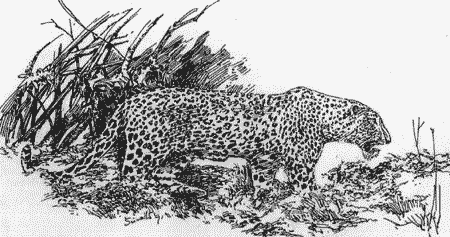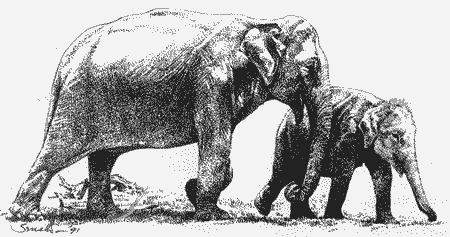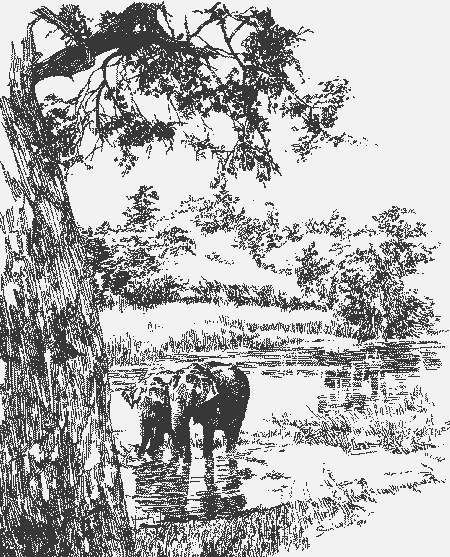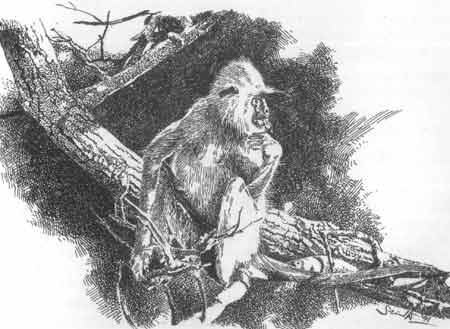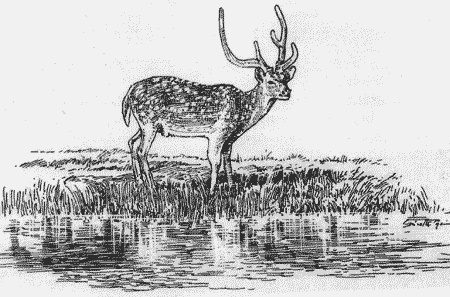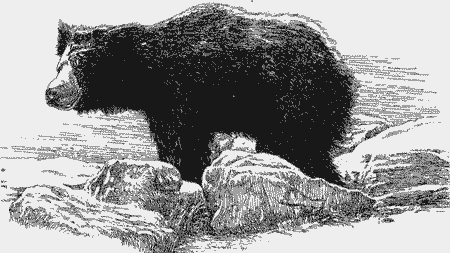|
| |||||||||
 Where Veddahs Cursed and Leopards Dispensed Justice
by Sam WickramasingheAlmost inaccessibly hidden deep in the Ruhuna jungles is a hallowed spot where Veddahs worshipped in the dim past and gathered to curse, swear and to seek punishment for wrong-doers. Legend has it that when an offence was committed, both complainant and suspect used to come here with suitable offerings and lay their grievance at the foot of the jungle ‘deviyo' and retire to two rocks nearby. It was the belief that during the night a leopard was sent by the guardian goddess to dispense justice and dispose of the guilty party. Today, the haunt of bear, leopard and elephant place is known as Kebbilitte (which means ‘potsherd' in Veddah parlance) nestles near the left bank of Kumbukkan Oya 22 miles upstream of Kumuna with only an etching of a bo-leaf on a Kumbuk trunk, for a sign to indicate the leading footpath, past an aged bo-tree and a chaitya ruin. ExpectancyThe first time I went to this place, we had to park the jeeps at a timber camp along the riverside and walk seven miles on in animal track to reach our destination. We camped one night on the right bank, sleeping under the stars after a hearty meal cooked on the spot by the pingo carriers who brought the victuals and baggage. It was quite an impressive party, international in character, with a Tamil, seven Westerners which included an Australian, a German and myself, with the Kumana folk making up the Sinhalese. There was an air of solemn expectancy as our guide, Garuwa, enjoined subdued conversation until the visit was over. At 3 a.m. next morning, he crossed the river with us to do a puja, at the shrine, which he said was done to traditional Veddah style. Seven wells were dug by hand on a sand bar and all of us had to bathe seven times from each before we marched In single file, after him dripping wet (we were asked not to dry ourselves) for the ritual which consisted of an offering of seven kinds of fruits and grain. We were shivering with cold in our wet clothes at that hour of dawn, and were thankful when he lit a fire to boil the rice offering. The shrine itself had no sign of any former buildings, other than the old chaitya and bo-tree referred to earlier. It was just a small clearing, circular in shape, with a wild tree of some sort growing in the centre. OfferingsThis tree was rooted by five thick offshoots which bore down from about two feet above ground. Garuwa said that in olden times a tamarind tree had stood there and the place was still called Siyabalawa by the villagers of Kotiyagala-Okkampitiya in the west and Siyalambalanduwa-Moneragala in the north. They were reputed to visit the place even now, trekking through the forest, offering the finest grain after harvesting, and for ceremonies involving curses and vows. We also noticed that not even a blade of grass was seen in grow within the circle area, about 30 feet in diameter, in spite of the (act there was no ‘gardener' living this side of 40 miles of more to tend the site regularly. Garuwa said this was a mystery which only the Deviyo could answer. He also pointed out to us the two rocks — known as ‘swearing rocks' — on which the people slept, expecting justice. They were in the middle of the river nearby, forming a triangle with the shrine as its apex. Around the circular path were a number of flat stone for lighting oil lamps and for offerings. A second visit one year later, with Australian friend Barry Windsor [who later remained in Ceylon to become known as Narikutti Swami, disciple of Nallur Yogaswami], was full of incident. One evening, Barry and went for a walk towards Kumana along the river. Soon my pal struck his toe-nail against a tree-stump and was bleeding profusely. First aid with a wild leaf and a strip of sarong plus much agitated talk took our eyes away from the guiding river. Before long, we had veered into thick overgrown forest with no track or river on sight. The time was about 5 p.m. and already dark and it was a supreme effort to keep panic down. Just then the sinister stillness of the surroundings was rent by the mighty trumpet of an elephant. Or, was it? Later we were to learn that we were fooled by the startled bark of a sambhur in the bush close to us. Fortunately, we felt no fear, each drew courage from each other. Barry climbed a tree and saw something like a hill nearby, to the right. Silently, cautiously we crept, guessing our way through the thick foliage. My friend was correct and that rock saved us. It was going to be our Hilton for the night — but also for visitors already there before us —elephants quite noisily (fortunately) breaking branches of trees. Having got our scent, they crashed away into the jungle. As night advanced the silence of the place seemed to gather body until it became an almost palpable presence. Intermittent cries of animals were heard, most of which we failed to identity except for those of elephant, leopard and bear. A beacon in the far horizon to the south indicated our position to be somewhere close to the Basses off the east coast. We were two grownup babes lost in the woods! RuinsNext morning, we were in for a discovery. The place was full of ruins of different sizes — walled-up caves with drip-ledges and headless Buddhas. The flat summit had three small, equal-sized chaityas ruined by age and by treasure hunters. Obviously, the site was that of an ancient monastery with monks living In these caves, and perhaps this explained the singular silence we felt so sharply during the night. We were to learn, later, that this surmise was correct and the location was the habitat, of arahats (spiritually realised souls) about 2000 years back. The hill was locally known as Diwulanagala — owing to the profusion of woodapple in the area. More appropriately, some called it Viheragala. Scanning the vicinity from the top we were jubilant to realise that we were not far from our camp as we saw the ridge of kumbuk trees giving us the direction to the river. Later, at Kebbilitte, we had another surprise. During our absence a ‘thief' had sneaked in and helped himself to some Kraft cheese from the sack. One sack had deep impression on top indicating that the visitor had probably, cushioned his back as he enjoyed the cheese. The half-opened tin he had left behind was on the ground, empty, with the lid completely wrenched off. One puzzling feature was the fact that whoever it was, had only eaten the cheese, and left other tempting eats like raisins, biscuits, etc., untouched. Then we saw the visiting card, of the nocturnal prowler on the ground — dung — a bear with a predilection for Australian cheese! Barry exclaimed with a wry smile that it he hadn't hurt his to and it had not lost our way the evening, before, he may have been the substitute for the cheese! Our long stay was well compensated with thrills and many exciting incidents. More ruins and caves were found. Some had Brahmi script, still discernible though faded, above the drip-ledges. A tracing of one was taken, and with the help of the Archaeological Department we were able to read it. The ancient ‘Hela' script proclaimed the gift of land by the then reigning monarch, to the Sangha. One day, digging the bottom of a six-foot tall ant-hill attached to a rock to take some clay for the construction of a hearth, we unearthed thick, dish-pattern clay pottery. This, too, was said to be at least 2,000 years old. These appeared to have been stacked neatly before time put the ant-hill above it, suggesting a mass exodus from the place. What could have brought this about, we wondered? Enemy attack, famine, pestilence? who could say? HermitageA study of the layout of Dimulana gala indicated that this must have been of some importance as a hermitage In the dim past. A series of steps cut into the rock surface approached the top from all four sides. The southern view from top dropped into a deep valley, with the two humped rock, Dematagala, in the distance. Beyond it loomed, another hill — a towering giant, red in colour, dominating the landscape, from the timber men we found out its name — "Tala-guru hela" — an intriguing name as it could mean either ‘the Hill of the Head Guru' or ‘Hill of brown earth'. It was rumoured that a solitary monk lived there; and though we made an at tempt to reach this hill, we had to give up midway owing to very thorny bush and the absence, of it track.
On the northern aide, the most outstanding feature was a chimney-like rod-shaped rock, tall and narrow, reminding one of a large Siva lingam. It dominated the jungle landscape like a bit of Gothic architecture! Halfway up Diwulanagala, a pond about 60 by 40 feet, apparently constructed to collect rainwater flowing down from the rock, for use by the monks, is now a popular rendezvous of the denizens of the wild. It was full of silt, and had only three feet of water. If the Wild Life Department cleans this, it would be a good source of water for the animals, during the drought when even the river dries up. On the rock surface, here and there, were deep holes of a foot to a half in diameter. These retained water longest, and it was interesting to note how elephants have put in large stones, inside to raise the water-level to drinking position. We also came across evidence of poaching and illicit gemming along the river banks. A few miles northeast we detected a marshy plot with signs of paddy cultivation, cheek by jowl with a ganja plantation — well-hidden in the jungle. One morning we stopped in our tracks, seeing an ant-eater which came right to us and then ran away in panic and fear! In a ‘kema' I surprised a beautiful young leopard, barely 15 feet away, at ten o'clock in the morning. Hurriedly, I called Barry to view this rare sight. He came rushing down with axes (we had no firearms) thinking that I being attacked by a bear. The memory of two bears he had the previous evening, just 13 feet away when he went to fetch some ‘kara-pincha' (curry leaves) for cooking, was still fresh in his mind! On another occasion, we heard arumpus like some grownups fighting and hurling loud abuse at each other. Investigation revealed two bears fighting near the pond. A BearOne evening, after dark, we ventured out of our cave-dwelling, and before we got to the pond, we heard the unmistakable hoot of a bear coming up the rock. We beat a hasty retreat. When I got to the cave, I found Barry missing. He was up a tree! Sleeping inside the cave was the safest — animals never bothered us here. One moonlit night, an elephant came right up to the entrance and went away. Getting up from a siesta one afternoon, I was startled to see the track and slough of a reptile on the dusty floor, a few inches away from my head! It had come out of a hole and slithered off! Barry thought that the headless Buddha the slept beside, and to whom I lit an oil lamp daily, had protected me from harm. Just after Poson — over a month later — the traction called again to take us back. Before we left, we scattered some papaw seeds, and planted some mango, jak and avocado near the river to commemorate expedition. We hoped that these would grow up some day — provided the monkeys, elephants and the drought permitted it! Colombo: The Ceylon Daily News of Monday January 5, 1981
|
